Store your essential oils in dark amber or cobalt blue glass bottles with tight seals, keeping them in a cool, dark place away from sunlight and heat sources. You'll want to organize oils by botanical families or aromatic properties using wooden storage boxes or dedicated shelving systems. Don't forget to label bottles clearly with key information and expiration dates. Proper storage techniques protect your investment and maintain therapeutic benefits – discover how to create the ideal setup for your collection.
Essential Oil Storage Basics: Temperature and Light Control
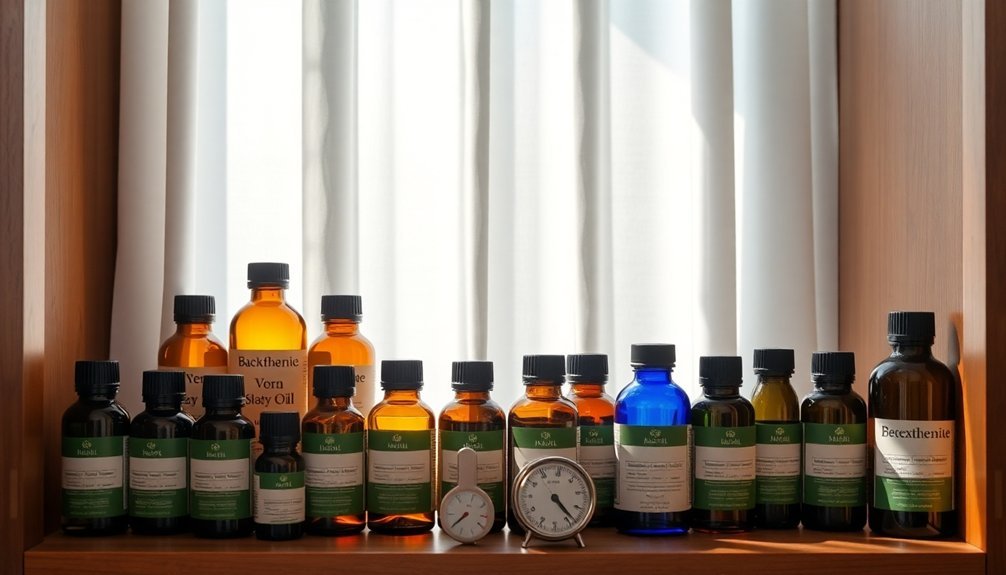
While essential oils can enhance your well-being, proper storage is crucial for maintaining their therapeutic properties.
You'll want to keep your oils in a cool, stable environment away from temperature fluctuations that can degrade their quality. Avoid storing them near heat sources like radiators, stoves, or sunny windowsills, as heat can cause volatile compounds to evaporate and alter their chemical composition. Using wooden storage boxes provides an extra layer of protection for your collection.
Light protection is equally important. Store your oils in dark amber or cobalt blue glass bottles, which shield them from harmful UV rays. Clear glass or plastic containers won't provide adequate protection.
For ideal preservation, keep your bottles in a dark place at room temperature. While refrigeration isn't necessary for most oils, you might consider it for rare or expensive varieties in very hot climates.
Creating a Dedicated Storage Space for Your Collection
Once you've built your essential oil collection, creating a dedicated storage space becomes crucial for both organization and safety.
You'll want to choose a cool, dark location away from direct sunlight and heat sources, while keeping your oils accessible yet secure from children and pets. Most oils will maintain their potency for 1-5 years when stored properly.
- Transform existing furniture into storage solutions by repurposing shelves, cabinets, or spice racks specifically for your oils.
- Use drawer organizers or wooden boxes with foam padding to protect and categorize your collection.
- Group oils by botanical families or frequency of use, and label everything clearly for quick identification.
- Include dedicated spaces for related supplies like carrier oils and empty bottles.
Consider converting a bathroom cabinet or closet shelf into your oil station, ensuring proper ventilation and temperature control while reducing visual clutter in your living space.
Glass Bottle Selection and Material Requirements
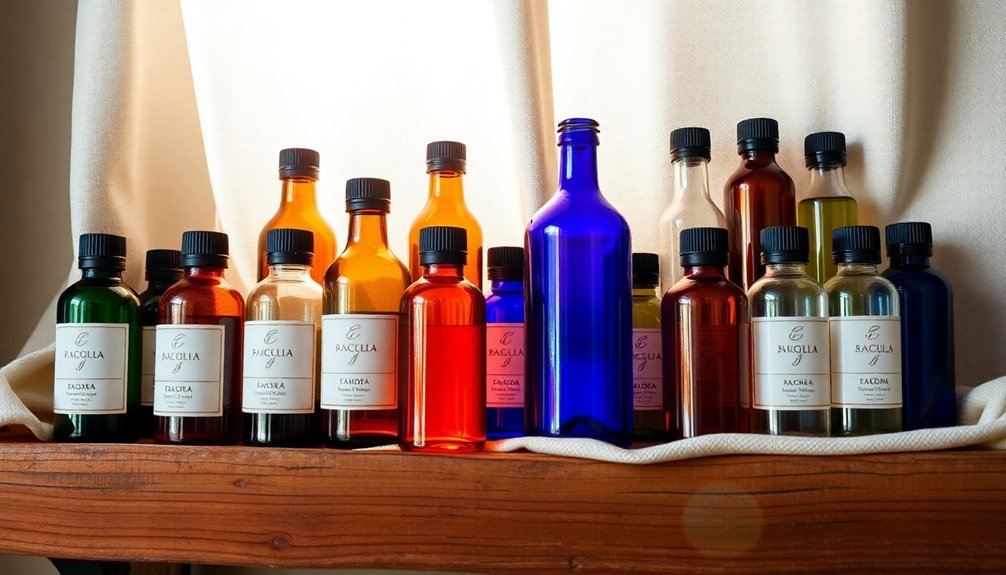
When choosing bottles for your essential oils, amber glass stands out as the superior choice due to its exceptional UV protection and ability to preserve therapeutic properties.
While clear glass bottles are common, they'll require storage in completely dark spaces to prevent UV damage and degradation of your oils.
Dark-colored bottles, particularly amber ones, offer built-in protection against harmful light exposure while maintaining the oil's integrity, making them worth the investment. Thicker glass walls provide additional protection against breakage and help maintain consistent temperatures during storage.
Amber Glass Benefits
Since essential oils are highly sensitive to environmental factors, amber glass bottles provide crucial protection that helps maintain their therapeutic properties.
You'll find that these specialized containers offer superior protection against UV radiation within the 10-400 nm range, preventing degradation and oxidation that can alter your oils' effectiveness.
- The inert glass composition won't react with your oils, ensuring they remain pure and free from chemical contamination that plastic containers might introduce.
- You're getting excellent durability for long-term storage, with bottles that maintain their integrity for years.
- The amber glass effectively blocks harmful UV rays, preserving your oils' chemical makeup and therapeutic benefits.
- You're making an eco-friendly choice, as these bottles are recyclable and often made with post-consumer materials while being easy to sterilize.
Clear vs. Dark Bottles
Choosing between clear and dark glass bottles can greatly impact your essential oils' longevity and potency. Clear glass bottles won't protect your oils from harmful UV rays and visible light, which can quickly degrade their therapeutic properties and fragrance.
You'll want to avoid them for storing pure essential oils. Instead, opt for dark glass bottles in amber, cobalt blue, or green. These colors effectively block UV radiation and help maintain your oils' chemical composition and purity.
While glass bottles may cost more and weigh more than plastic alternatives, they're worth the investment. Glass is inert, non-reactive, and won't contaminate your oils like plastic can. Plus, it's recyclable and environmentally friendly.
Don't compromise on quality – dark glass bottles are your best choice for preserving essential oils.
Organizing Oils by Botanical Families and Properties
You'll find that organizing your essential oils by plant families (like trees, flowers, and herbs) creates a logical system that makes locating specific oils quick and easy.
Grouping oils by their aromatic properties, such as citrus or woody scents, further enhances your ability to select the right oils for blending and aromatherapy.
These organization methods, combined with proper storage solutions, help maintain oil quality while ensuring you can access and use your collection effectively.
Group by Plant Source
Organizing essential oils by plant source creates a logical system that helps you understand their properties and uses more effectively.
You'll find that different plant parts yield oils with distinct characteristics and therapeutic benefits.
1. Leaves – From eucalyptus to tea tree, leaf-derived oils are often powerhouses of therapeutic compounds.
You'll find these particularly useful for respiratory support and cleansing.
2. Flowers – Oils like rose and jasmine come from delicate blooms, offering gentle properties perfect for skincare and emotional well-being.
3. Wood – Cedarwood and sandalwood oils provide grounding, calming effects.
Remember that some wood-sourced oils come from endangered species.
4. Citrus Rinds – Expressed from fruit peels, these uplifting oils like bergamot and lemon brighten your mood and add zest to your blends.
Storage System Benefits
When essential oils are grouped by botanical families and properties, a world of practical benefits unfolds for both novice and experienced users. You'll find oils faster, blend more effectively, and protect your collection from environmental damage. This systematic approach helps you maintain ideal storage conditions while making your aromatherapy practice more efficient.
| Family Type | Key Benefits | Storage Tips |
|---|---|---|
| Citrus | Easy identification | Store in fridge |
| Floral | Complementary blending | Dark containers |
| Woody | Thematic grouping | Cool location |
| Herbal | Quick access | Airtight seals |
| Medicinal | Therapeutic matching | Separate shelf |
Classification Methods That Work
A well-planned classification system transforms your essential oil collection into an intuitive and practical resource.
You'll find two primary methods work best: organizing by aromatic properties or botanical families. The aromatic approach groups oils into 18 distinct categories like citrus, floral, and camphorous, while the botanical method sorts them by plant origins such as trees, flowers, and herbs.
- Sort oils by their dominant scent characteristics for aromatherapy purposes
- Group by botanical families to quickly locate specific plant-based properties
- Combine both methods for a thorough organization system
- Use adjustable storage solutions with clear labels for each category
Consider creating your own hybrid system that reflects how you use your oils, making them easily accessible while maintaining proper storage conditions.
Labeling Systems for Easy Identification
Proper labeling systems form the foundation of safe essential oil storage and efficient organization.
You'll want to include essential information on each label: the oil's name, manufacturing/expiration dates, batch codes, and any safety warnings.
For custom labels, you can use durable BOPP or weatherproof polyester materials that resist tearing and weathering.
If you're printing labels in-house, choose printers designed for narrow labels that can handle ingredient lists, warnings, and barcodes.
This gives you flexibility to create labels for new blends or seasonal products without delays.
Make sure your labels maintain consistent branding elements like your logo and design theme while clearly displaying usage instructions and benefits.
For maximum durability, opt for laminated roll labels, especially if your oils are exposed to varying temperatures or moisture.
Child-Proof Storage Solutions and Safety Measures

Since essential oils can be harmful if mishandled, implementing child-proof storage solutions becomes crucial for household safety.
Store your oils in a high cabinet or locked storage unit that's out of reach from children and pets. You'll want to invest in wooden boxes or specialized storage containers that protect oils from light while keeping them organized and secure.
- Always use child-resistant safety caps on your essential oil bottles
- Store oils in a locked cabinet with safety latches
- Keep containers away from areas where children play
- Choose storage units that aren't easily moved or tampered with
Remember to handle oils with clean hands and avoid direct skin contact with undiluted products.
If you're using oils around children, opt for pre-diluted versions in roller bottles and always perform patch tests first.
Custom Storage Solutions for Different Collection Sizes
Whether you're just starting out or have amassed dozens of bottles, finding the right storage solution for your essential oil collection is key to maintaining their potency and accessibility.
For small collections, try a Lazy Susan on your counter or utilize your medicine cabinet with labeled boxes.
If you've got a medium-sized collection, consider installing dedicated shelves or using tiered storage solutions with drawer organizers for easy access.
Large collections require more robust solutions. You'll want to invest in multi-layer wooden boxes or large plastic bins with foam inserts.
Organize your oils by category or alphabetically, and don't forget to store citrus oils in the refrigerator.
For those who travel with their oils, hard shell cases and protective wrapping will keep your collection safe on the go.
Maintaining Proper Inventory Records
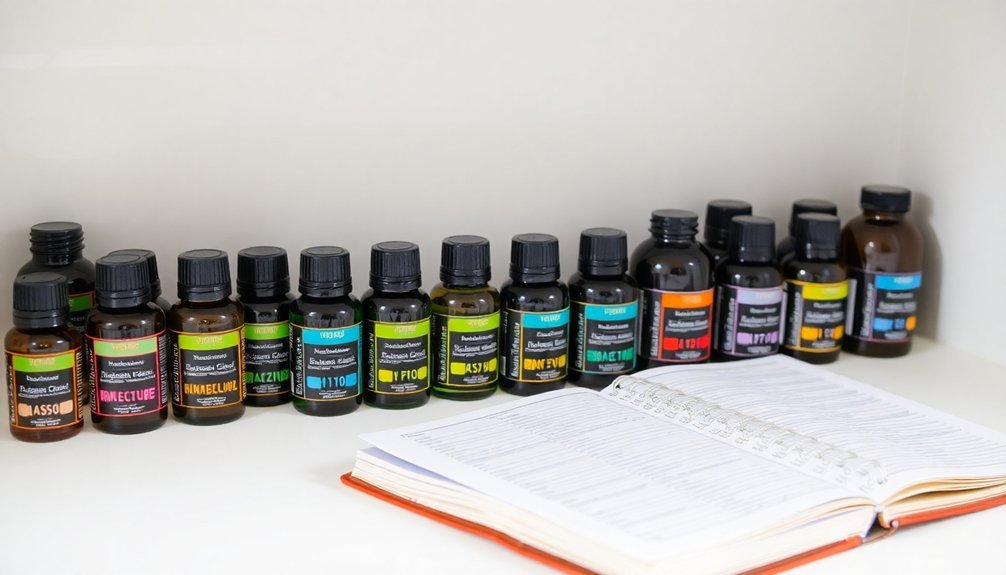
Managing your essential oil collection requires a robust digital tracking system to monitor usage, expiration dates, and stock levels.
You'll want to perform monthly stock checks to verify your inventory matches your records and identify any oils that need replacement.
Document each oil's storage life by recording purchase dates and expected shelf life, which helps you rotate stock effectively and maintain the potency of your collection.
Digital Tracking Systems
To stay organized with your essential oils collection, digital tracking systems offer modern solutions for maintaining accurate inventory records.
These tools help you track quantities, monitor expiration dates, and manage your purchasing decisions efficiently.
- Use Notion's free template to create a thorough database of your essential oils, complete with retail and wholesale prices, while tracking samples and customer interactions.
- Try Oil Shelf App's Shelfie Cam feature to quickly scan and catalog your Young Living products, with helpful reordering alerts.
- Track spending patterns and generate tax reports with EO Inventory App's detailed reporting system.
- Consider DiracERP for professional operations, offering advanced analytics and compliance management for larger essential oil businesses.
Choose the digital system that best matches your needs and collection size to guarantee proper inventory management.
Monthly Stock Check Process
Successful essential oil management hinges on a consistent monthly stock check routine. You'll need to count, inspect, and document every bottle while comparing actual quantities against your safety stock levels.
During your monthly check, examine each oil for quality changes in color, consistency, and aroma. Look for signs of oxidation and verify all containers and lids remain in good condition.
Update your inventory records, noting any oils that are approaching their minimum levels or showing signs of deterioration. Sort your oils by botanical families and usage frequency, confirming that labels are clear and categories are properly organized.
Keep your most-used oils easily accessible while maintaining proper storage conditions. If you notice stock approaching safety thresholds, set alerts in your tracking system to trigger timely reorders.
Storage Life Documentation
Proper documentation forms the backbone of your storage life management system. You'll need to track each oil's journey from purchase to final use, ensuring you're always aware of its freshness and viability.
Keep detailed records of purchase dates, opening dates, and remaining quantities to maintain ideal quality.
- Create a centralized tracking system that includes essential details like oil type, constituents, and common uses.
- Record storage conditions, including temperature (35-40°F), humidity levels, and location details.
- Monitor shelf life expectations – citrus oils last 6-12 months, while woody oils can last 2-6 years.
- Document regular quality checks by noting changes in smell, appearance, or consistency.
Remember to update your records when transferring oils to smaller bottles or making changes to storage conditions.
This systematic approach helps you maintain a fresh, effective essential oil collection.
Travel-Friendly Storage Options
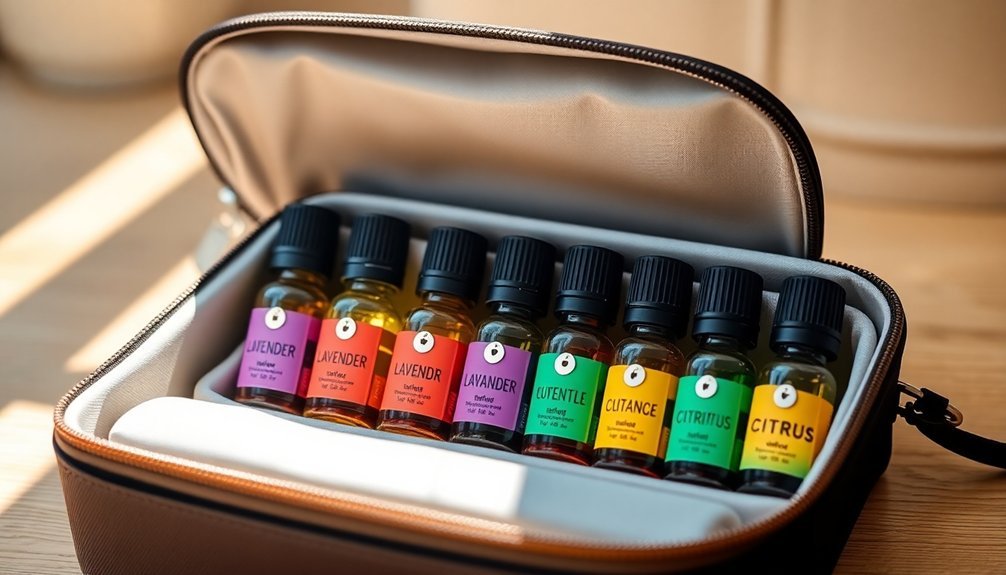
While traveling with essential oils requires careful planning, several storage solutions make it easier to transport your collection safely. You'll find both hard shell cases made from ABS plastic that protect against breakage and lightweight fabric options that fit easily in your purse or bag.
Look for cases with foam inserts or dividers to keep your bottles upright and organized. The best travel cases feature strong zippers, double-stitched seams, and labelled slots so you can quickly identify each oil.
If you're carrying roller bottles or smaller vials, choose specialized cases designed for these specific sizes.
For added convenience, select a case that accommodates various bottle sizes from 5ml to 15ml, and consider options that include space for related items like cotton balls or dried herbs.
Environmental Factors Affecting Oil Storage
Essential oils require specific storage conditions to maintain their potency and therapeutic properties. To protect your oils from degradation, you'll need to take into account four key environmental factors that can greatly impact their quality and effectiveness.
- Light exposure can damage your oils, so store them in dark amber or cobalt blue bottles and keep them away from UV rays.
- Heat causes volatile compounds to evaporate, so avoid placing oils near heat sources like radiators, stoves, or sunny windowsills.
- Air exposure leads to oxidation, reducing therapeutic benefits, so use bottles with tight seals and orifice reducers.
- Moisture and humidity can introduce impurities and promote bacterial growth, so store your oils in dry, well-ventilated areas away from bathrooms and kitchens.
Storage Solutions for Blending Workstations
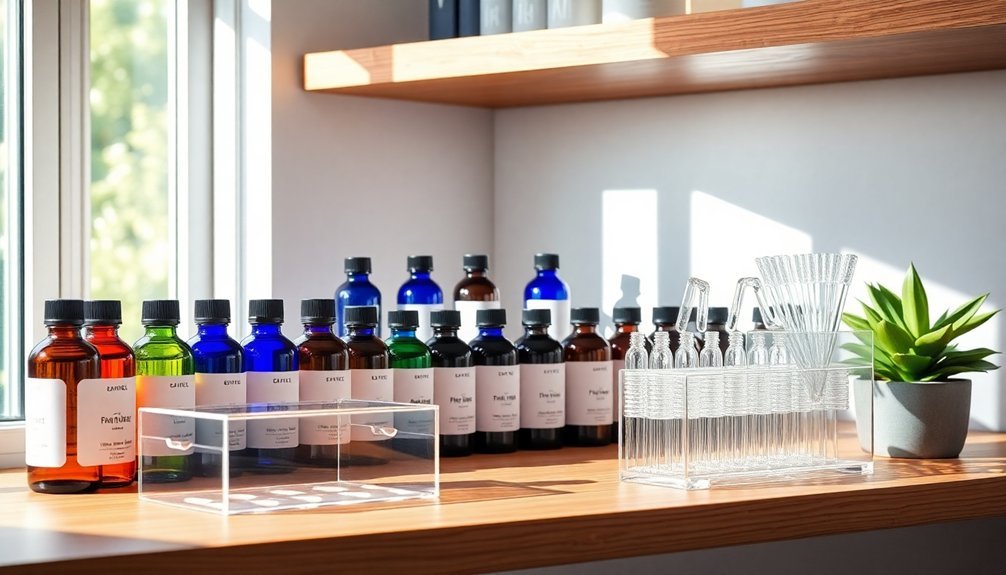
Setting up a functional blending workstation starts with smart storage solutions that keep your oils organized and within reach. You'll want to combine practical organization tools with protective storage options that shield your oils from light and temperature fluctuations.
| Storage Type | Best Uses |
|---|---|
| Lazy Susan | Quick access to frequently used oils |
| Wooden Boxes | Light protection and durability |
| Drawer Systems | Large collection organization |
| Carrying Cases | Mobile blending sessions |
| Tiered Racks | Space-efficient display |
Consider using foam padding to protect bottles and label makers to identify oils quickly. If you're working with limited space, repurposed spice racks and medicine cabinets offer excellent alternatives. For mobility, opt for secure cases with proper ventilation, especially when you need to transport your collection between different workstations.
Digital Tracking Systems for Oil Collections
Three key benefits make digital tracking systems invaluable for managing your essential oil collection: inventory control, financial oversight, and compliance management.
With extensive databases integrating platforms like Notion, you'll streamline your organization while maintaining accurate records of your oils.
- Track your entire inventory in real-time, preventing duplicate purchases and monitoring samples, unboxed items, and in-use bottles.
- Generate financial reports to analyze spending patterns, optimize purchases, and simplify tax deductions for business expenses.
- Maintain compliance with regulations through automated documentation and standardized record-keeping.
- Access advanced analytics to improve efficiency, manage complex formulations, and guarantee consistent product quality.
These digital tools transform how you organize your collection, making it easier to focus on creating while maintaining professional standards.
Frequently Asked Questions
Can Essential Oils Be Stored in Plastic Dropper Bottles for Short Periods?
You shouldn't store essential oils in plastic droppers, even briefly. The oils can quickly degrade plastic, leaching harmful chemicals into your oils and reducing their potency. Always use glass bottles instead.
How Long Can I Keep Opened Essential Oil Blends Before They Expire?
You'll need to use your opened essential oil blends within 6-12 months for best results. However, if you store them properly in dark bottles and cool places, they can last up to 2-3 years.
Should Different Brand Essential Oils Be Stored Separately From Each Other?
You don't need to separate essential oils by brand. Instead, focus on organizing them by category (floral, citrus, woodsy) or alphabetically for easier access. Just make certain they're all in proper glass containers.
Does Storing Oils Near Electronics Affect Their Properties or Shelf Life?
You don't need to worry about storing oils near electronics, as they won't affect your oils' properties or shelf life. Focus instead on protecting them from heat, light, and air exposure.
Can Essential Oils Be Stored in the Refrigerator for Longer Preservation?
Yes, you can store essential oils in your refrigerator. The cool temperature (35-38 degrees) will extend their shelf life, especially for citrus oils. Just let them warm up for 1-2 hours before use.
In Summary
Store your essential oils properly, and you'll protect your investment while maintaining their therapeutic properties. Keep them organized in dark glass bottles, away from light and heat, and use a clear labeling system that works for you. Whether you're tracking digitally or manually, staying organized helps you blend confidently and access your oils easily. With these storage habits, you'll enjoy your oils' benefits for years to come.

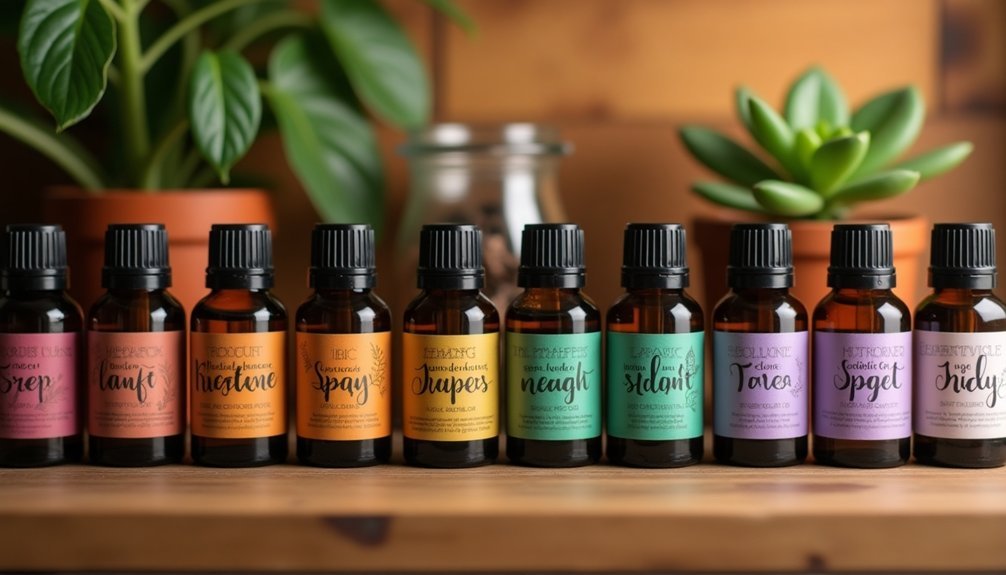



Leave a Reply